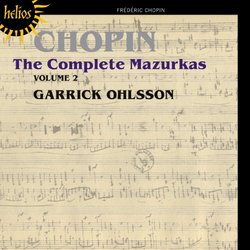Some of the Most Magnetic Piano Playing in Decades...
C. Pontus T. | SE/Asia | 04/02/2010
(5 out of 5 stars)
"In the words of Frank Cooper (author of the liner notes of the original Arabesque twofer incarnation)--'Although these mazurkas' design usually permits amateur performance (a quality much valued by publishers), the expression of their content can elude all but the most sophisticated interpreters.'
Therefore, it would probably be fair to say that the Chopin Mazurkas are particularly suited for connoisseur pianists (won't get into a discussion of definition here, but only state mine: first-rate performers whose sophisticated refinement remains elusive to the wider public)--above all Ohlsson and Moravec. Against this background, I do not particularly lament that Argerich has only taken on a select few of them; moreover, it makes sense to me that Pollini has avoided them altogether. Without any intention of being a tedious naysayer, I predict that Yundi Li's Mazurkas, as part of his recently announced, pending complete Chopin survey on EMI, will have little to offer of interest.
The aforementioned is not to demean the competition but rather an attempt to shed light on the unique combination of Chopin's most deeply personal works and Ohlsson's selflessly illuminating renditions of the same--resulting in some of the most magnetic piano playing this reviewer has yet come across during two decades of collecting primarily piano records. As always with Ohlsson's Chopin playing, it reaches its summit in the most introspectively elegiac and nostalgic pieces where he takes us to previously unknown territory--such as Op 50/3, Op 56/1/3, Op 59/1, Op 63/2-3 and Op 68/2.
Frank Cooper offers some memorable words about three of them: '[Op 56] No. 1's large structure and elaborate harmony mask an introverted soul - Chopin himself? - lost in nostalgia'; 'No. 3, a great favorite of many pianists, displays a large format with many exquisite turns of phrase and ingenuities of harmony yet it, too, is more an evocation of the country which Chopin abandoned than any realization of it'; '[Op 59] No. 1 opens the set by venturing, as Huneker put it, "off the familiar road to some strange glade, wherein the flowers are rare in scent and colour"'.
The so-called professional critics have largely and inconceivably neglected Ohlsson's reference survey of the complete Chopin oeuvre. As an exception to the rule, Jed Distler ([...]) writes--'Garrick Ohlsson strikes a balance between Rubinstein's aristocratic introspection and Horowitz's necromantic musings. His light, airy touch brings out the skittish, playful side of these works. The pianist pays heed to Chopin's endless harmonic felicities by gently stressing inner counterpoints and sleight-of-hand modulations. Arabesque's clear and resonant engineering matches Ohlsson's conceptions to a proverbial tee. A marvelous release.' Furthermore, one can read in the recent February issue of BBC Music Magazine--'Not only does he catch the rhythm, but his feel for nuance and colour misses no element of Chopin's infinite imagination, and the balance of earthiness and elegance is well-nigh ideal. [...] Ohlsson brings a phenomenal variety of expression and depth of characterisation to these exquisite miniatures - an approach that manages to capture the folk elements of the composer's style to quite hypnotic effect.'
This closes my reviews of Hyperion Helios's seven bicentennial compilation reissues from Ohlsson's reference Chopin survey--which, by a substantial margin, remains the most desirable treat in this year of commemorating the greatest genious of the piano the world has seen.
REFERENCE: This One"
LAST MAZURKA IN PARIS
DAVID BRYSON | Glossop Derbyshire England | 05/26/2010
(4 out of 5 stars)
"This disc completes Garrick Ohlsson's fine set of the Chopin mazurkas. There are 28 of them here, following the opus-number sequence up to op 63, then alternating 8 compositions of various dates and lacking opus numbers with the posthumous opp 67 and 68 works. If I have understood the liner note rightly, 5 other pieces have been excluded, I suppose on grounds that they are adjudged spurious, although the matter is not spelt out.
Ohlsson's concept of the mazurkas is full-blooded and vigorous, although by no means wanting in delicacy of touch when needed, much less in delicacy of feeling. This approach is particularly well suited to the first number here, op 50/1 in G major, getting the disc off to a very promising start. You may find the piano recorded too close-to, but I prefer to put up with this as a very minor shortcoming rather than reduce the volume and so lose impact from the performance. There is no hint of distortion, the piano (Mason & Hamlin rebuilt by Mr William Schneider of Michigan State University) is agreeable in tone, and the sound is altogether in keeping with the artist's idea of the pieces.
The promising start goes on to fulfil its promise, I'm happy to say. If anything, I find Ohlsson's playing even better on this disc than on the first, particularly in the late works. Op 68/4 is Chopin's very last composition, which he was too enfeebled to play himself. You will not miss its significance as played here, and indeed Ohlsson shows deep and sympathetic perception of the intensely personal tone of the mazurkas all the way through both discs. In my notice of the earlier disc I suggested that Michelangeli provides us with an altogether higher experience of piano-playing, and I must in honesty stick by that opinion when it comes to the 6 numbers on his Chopin recital disc that duplicate what we find here, but that is another issue. If you are looking, as I was looking, for a fine complete set of these deep and soulful compositions that does proper justice to the unity in variety that they offer then I believe you will find a worthy tribute here to Chopin's memory in his bicentennial year."

